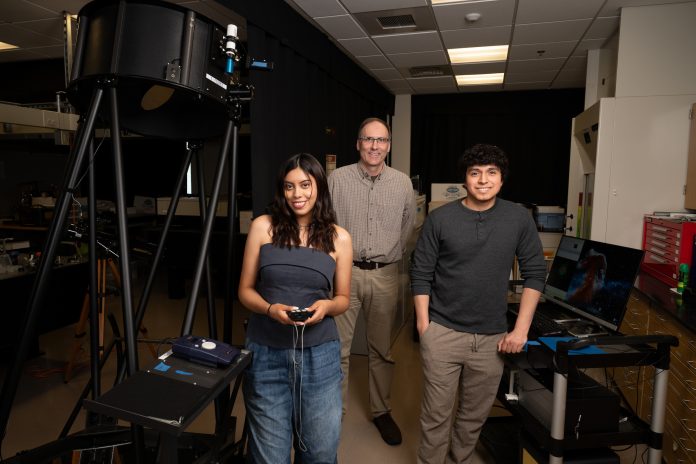Physics major Sebastian Lucero, ’25, spent his first two years of college at the University of Connecticut but he transferred to Southern as a junior seeking more hands-on experience.
“The UConn department is much bigger, so it feels a lot more impersonal,” he says. “That didn’t align well with the way I learn. At Southern, the department is much smaller. It’s a lot easier to develop personal relationships with professors, and there are also so many opportunities here. Southern has that sense of community, which is so important to me.”
Lucero, who graduated in May with a degree in physics and a minor in mathematics, focused his capstone project on astronomy. Southern has a unique multi-telescope instrument that measures the physical sizes of bright stars. Lucero, 22, focused on improving observation efficiency and streamlining data reduction.
Ana Baculima, ’25, also transferred to Southern — from Naugatuck Valley Community College (NVCC). “My physics professor at NVCC recommended Southern because it was small and rigorous. I got a chance to know all the professors, so it was a good fit for me. I do love it here,” she says.
A physics major with minors in astronomy and computer science, Baculima, 22, also graduated in May, focusing her capstone project on the telescope system’s camera setup.
Both capstone projects supported the astronomy lab’s primary work: a prototype telescope system capable of producing ultra-high-resolution images of stars through stellar interferometry — a cutting-edge technique in observational astronomy.
Southern’s growing research capabilities are drawing students from across the state and beyond. Its recent designation as a Carnegie R-2 research institution — the only university in Connecticut with this status — is helping fuel that momentum.
“We can give students the kind of research experiences you’d find at UConn or Yale, but we do it in a smaller department with personalized attention,” says Elliott Horch, chairperson of the Department of Physics. “Southern gives students amazing research experiences.”

Independent Thinkers
The various projects are funded through the Connecticut Space Grant Consortium (supported by NASA) and the National Science Foundation. “These grants enable us to get students doing important research, which then fully prepares them to do these amazing senior projects,” says Horch. At the beginning of their education, students are assigned tasks to build their skills, he explains.
“When they get to their senior level — where Sebastian and Ana were — we want them to function like mini principal investigators: they design the project and carry it out. I step back and act more as a mentor. It’s a semester-long commitment to take a research project from start to finish,” he says. “It’s so rewarding to see them develop not only as scientists but also as people and to see the camaraderie in my research group.”

Drawn to the Universe
Lucero became intrigued by astronomy during his first semester at Southern while exploring extracurricular activities. Horch, recognizing his curiosity, quickly invited him to join the research group. “I could see right away that Sebastian is very hands-on, confident, and fearless about trying new things,” he says. “Dr. Horch explained that our data collection method was unique,” Lucero says. “I was eager to join.”
Pursing a Childhood Dream
Astronomy has been Baculima’s passion since she was a child. “When I am working with the telescope at night, I am amazed by the vastness of space and how tiny we are. . . . It makes me curious to know what more we can find out there,” she says.
Horch quickly saw Baculima’s potential. “As soon as she took a class or two, we knew she would be near the top of her senior class. You tell her something once, and she’s got it. She has a mind like a steel trap. I think she can do amazing things in her career.”
Baculima, who moved from Ecuador to the United States when she was 15, says Southern opened doors she hadn’t imagined. “I had the chance to visit Apache Point Observatory in New Mexico. I was really impressed to see that they use the same camera and astronomy software that we use here in our labs,” she says.
Ready for What the Future Brings
Both Baculima and Lucero plan to pursue graduate studies. Baculima has applied for internships and then expects to enroll in a master’s level program, likely in astronomy or particle physics.
Lucero is still exploring which field of physics he’ll focus on at the graduate level. “I really enjoy astronomy,” he says, “but I may want to broaden my horizons a bit.”
Wherever the stars lead them, both students feel Southern has prepared them fully for the future. Lucero says, “I’ve gotten great advice from my physics professors about applying for master’s and doctoral programs, and about opportunities at various companies. I feel like I’ve learned a lot of skills that will help me in either route.”
Baculima agrees: “The physics department is so supportive. The professors want to get students involved in real research, so we can grow as scientists.”
Read more from Southern Alumni Magazine



